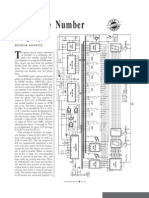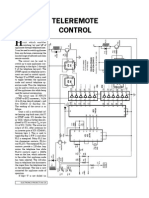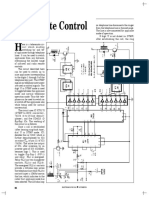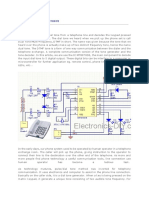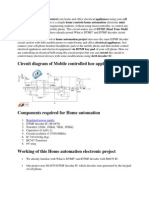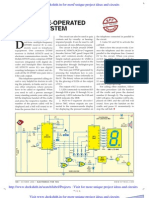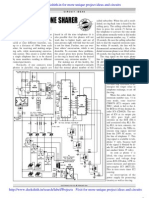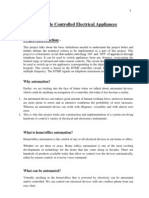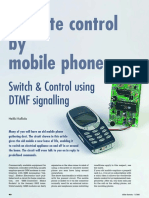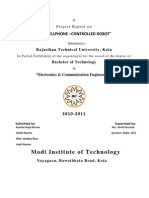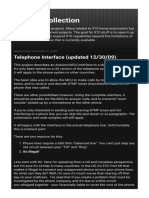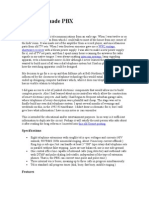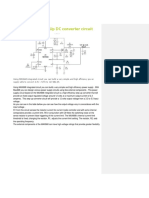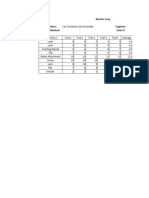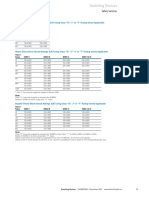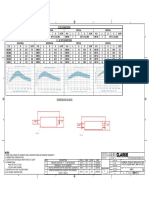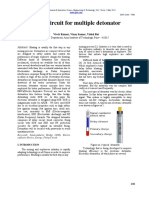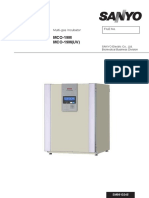construction
DEVICE SWITCHING USING TELEPHONE LINES
N. SHARMA
EM
TESTED
Narendra Sharma ere is a device switching circuit that enables switching 'ON' and 1 18 VDD 'OFF' of appliances through telephone IN+ line. The circuit can switch a maximum 2 17 SI/GTO of nine connected devices. Figure 1 INshows the block diagram of the device switching using telephone lines. It 3 16 GS ESO mainly comprises a DTMF decoder, demultiplexer. 15 4 DSO This circuit employs DTMF technique to VREF switch on/off up to nine appliances (corresponding to the digits 1 through IIN 5 14 Q4 KT3170 9 of the telephone keypad). It can be used to switch appliances from any 6 13 Q3 PDN distance, overcoming the limited range of IR and radio remote controls. 12 Q2 The digit '0' in DTMF mode is used to OSC1 7 toggle between the control mode and normal telephone operation mode. 11 Q1 OSC2 8 Thus the telephone can be used to switch on or switch off the appliances 10 OE also while being used for normal con- GND 9 versation. The circuit is built around IC KT3170 Fig. 2: Pin configuration of KT3170
74LS74 (Dual D-Type Flip-Flop) ICs.
The DTMF decoder:
DTMF decoder KT3170 is used here. It uses a 3.58MHz crystal for providing clock for its internal circuitry. The DTMF decoder decodes the signal received and provides a binary output corresponding to the key pressed from the telephone instrument. It decodes all 16 DTMF tone pairs into a 4bits digital code. After establishing a call and selecting the control mode of operation when you press any digit (1-9) on the telephone instrument, it receives a valid DTMF tone pair and decodes it into the corresponding 4-bit binary output, which is available at its pins 11 through 14. Figure 2 shows the pin configuration of this IC.
DTMF Decoder (Receiver)
(DTMF decoder), 74154 (4-Line to16Line Decoders/Demultiplexers), two Demultiplexer: 74LS04 (Hex Inverter) and five Demultiplexer 74LS154 is used here. This IC decodes four binary-coded inputs I Device 1into one of sixteen N mutually exclusive V outputs when both E the strobe inputs, E1 4 : 16 Relay R and E2, are low. The Demultiplexer Drivers T Device 9demultiplexing E f u n c t i o n i s p e rR formed by using the S 4 input lines to address the output line, passing data Power Power from one of the Supply Supply +5V +12V
Fig. 1: Block Diagram of the Device switching using Telephone lines.
�+5V +12VN/O
N/C
RL2 T2
+5V +12VN/O
N/C
RL4
+5V +12V
RL10
T4
D10
T10 GND
D2
R8
_D 12 Q 14
D4
R10
_D 12 Q 14
R16
_D 12 Q 14
8Q 9 11 IC5(B) 7
8Q 9 11 IC6(B) 7
8Q 9 11 IC9(B) 7
N/O
N/C
RL1 T1
N/O
N/C
RL3
PIN 3PIN 11 OF PIN 11 OF OF PIN 3 OF IC7(B) IC8(B) IC7(A) IC8(A) N1-N6 = IC3N7N/O N10 = IC4
T3
N/C
RL9
T9
D1
R7
_ Q Q
D3
R9
_Q Q
D9
R15
_ Q Q
2 4 16 5 3 IC5(A)
D
2 4 16 5 IC6(A)
D
2 4 16 5 3 IC9(A)
D
14
2 N1 1 2 3
4 N2 3 4
6 N3 5 5
8 N4 9 6
10 N5 11
12 N6 13
2 N7 1 8 9
4 N8 3
6 N9 5 10
8
N10 7
9 11
VCC 24 23
IC2 21 74LS154
22 20
19 18 12 GND
C2
SI/GTO R6 17
ESOQ1 16 11
Vdd 18
Q2 IC1 Q3
Q4 9 6
KT3170 14 13 12
GND
Fig. 3: Circuit diagram of Device switching using telephone lines
OE
10 3 2
R5 R4 C1 R1 R2
R3
1 IN- IN+
7 VREF OSC1
8 OSC2
IIN
XTAL
TELEPHONE LINE
N/O
N/C
�Fig. 5: Actual - size, solder-side PCB layout. strobe inputs with the other strobe input ring-back tone), dial '0' in ing low. When either strobe input is high, DTMF mode. IC1 decodes this all outputs are high. as '1010,' which is further demultiplexed by IC2 as output 10 (at pin 11) of IC2 (74154). The Circuit: The active low output of IC2, RL10 is energised. The The working of the circuit is as follows. Once a call is established (after hear-
COMP NETSLI
SEMICONDUCTORS IC1KT3170 DTMF Decoder IC274LS154 4-to-16 line decoder/demultiplexer IC3-IC474LS04 hex Inverter IC5-IC974LS74 D type flip/flop T1-T10BC547 Transistor D1-D101N4007
L X1 D11 230V AC 50Hz D13 N X1 = 230V AC PRIMARY TO 0-12V AC, 750mA SECONDARY TRANSFORMER D14 D11-D15 = 1N4007 D12 D15 IN 1 +12V
IC10 7805
OUT +5V C5 0.1 GND
RESISTORS R1-R2 R3 R4 R5 R6 R7-R16
22k 220W 10k 1M 330k 2.2k
C3 1000 25V
2 COM
C4 470 25V
CAPACITORS C1 C2
0.1 0.01
Fig. 4: Circuit Diagram of Power Supply
MISCELLANEOUS XTAL3.58 MHz Crystal RL1-RL10 12V, 200W, 1C/O Relay
�+5V GND.
D10
EC B
T10 R5 C2 R6 IC1 IC2 IC3 IC4 R16
N/C
Pole N/O
R4
XTAL Telephone Lines
1
R1 C1 R3 R2
IC5
IC6
IC7
IC8
IC9
R7 +12V D1
E B C
R8 T1 D2
R9 T2 D3
R10 T3 D4
R11 T4 D5
R12 T5 D6
R13 T6 D7
R14 T7 D8
R15 T8 D9
1
E B C
T9
RL1
RL2
RL3
RL4
RL5
RL6
RL7
RL8
RL9
N/OPole N/C
N/OPole N/C
Fig. 6: Component layout for the PCB.
after inversion by an inverter gate of '1' is dialed, it is decoded by IC1 and its removed from the telephone line. To be IC3 (74LS04), becomes logic 1. This is output is '0001'. This BCD code is thenachieve this, digit '0' (in DTMF mode) is used to toggle flip-flop (IC9 (B)) and de-multiplexed by 4-to-16-line dedialed again to toggle flip-flop-10 to relay RL10 is energised. The energised multiplexer IC2 whose corresponding de-energise relay RL10, which termiRL10 contact provides a 220-ohm output, after inversion by a 74LS04 nates the loop on line. The telephone loop across the telephone line. The inverter gate, goes to logic 1 state. This is thus again set free to receive line 220-ohm loop on telephone line dis- pulse toggles the corresponding flip- normal calls. This circuit is to be conconnects the ringer from the telephone flop to alternate state. The flip-flop nected in parallel to the existing teleline in the exchange. The line is now output is used to drive a relay (RL1) that phone instrument. connected for control mode of opera- can switch on or switch off the applition. ance connected through its contacts. If digit '0' is not dialed (in DTMF) after By dialing other digits in a similar way, establishing the call, the ring continues other appliances can also be switched and the telephone can be used for 'on' or 'off. normal conversation. After selection of Once the switching operation is over, the control mode of operation, if digit the 220-ohm loop resistance needs to
The author is a Computer Science Graduate from Kurukshetra University, Kurukshetra
